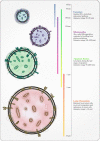Diagnostic Impact of Radiological Findings and Extracellular Vesicles: Are We Close to Radiovesicolomics?
- PMID: 34943180
- PMCID: PMC8698452
- DOI: 10.3390/biology10121265
Diagnostic Impact of Radiological Findings and Extracellular Vesicles: Are We Close to Radiovesicolomics?
Abstract
Currently, several pathologies have corresponding and specific diagnostic and therapeutic branches of interest focused on early and correct detection, as well as the best therapeutic approach. Radiology never ceases to develop newer technologies in order to give patients a clear, safe, early, and precise diagnosis; furthermore, in the last few years diagnostic imaging panoramas have been extended to the field of artificial intelligence (AI) and machine learning. On the other hand, clinical and laboratory tests, like flow cytometry and the techniques found in the "omics" sciences, aim to detect microscopic elements, like extracellular vesicles, with the highest specificity and sensibility for disease detection. If these scientific branches started to cooperate, playing a conjugated role in pathology diagnosis, what could be the results? Our review seeks to give a quick overview of recent state of the art research which investigates correlations between extracellular vesicles and the known radiological features useful for diagnosis.
Keywords: artificial intelligence; extracellular vesicles; radiology; radiomics; radiovesicolomics.
Conflict of interest statement
The authors declare no conflict of interest.
Figures
References
-
- Patil A.A., Rhee W.J. Exosomes: Biogenesis, Composition, Functions, and Their Role in Pre-metastatic Niche Formation. Biotechnol. Bioprocess Eng. 2019;24:689–701. doi: 10.1007/s12257-019-0170-y. - DOI
-
- Simeone P., Bologna G., Lanuti P., Pierdomenico L., Guagnano M.T., Pieragostino D., Del Boccio P., Vergara D., Marchisio M., Miscia S., et al. Extracellular Vesicles as Signaling Mediators and Disease Biomarkers across Biological Barriers. Int. J. Mol. Sci. 2020;21:2514. doi: 10.3390/ijms21072514. - DOI - PMC - PubMed
Publication types
LinkOut - more resources
Full Text Sources


